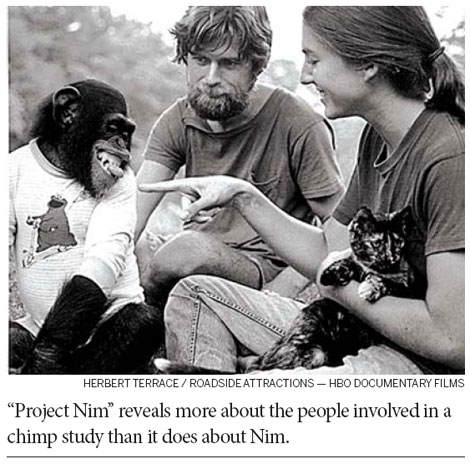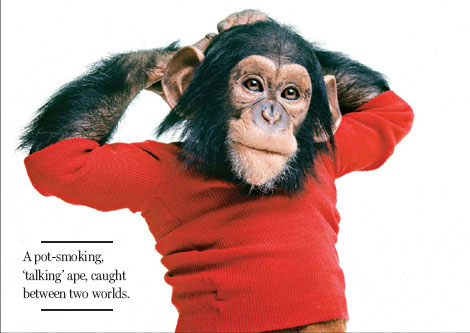Chimp's bio: A sad tale of hubris

What would it mean for an animal to talk? What indeed separates an animal from a human? These questions are raised in a new documentary about a chimpanzee named Nim Chimpsky, the subject of a radical language experiment in the 1970s.
The film, "Project Nim," is named after the study, which began in 1973 with an infant Nim living with a Manhattan family and ended after much tribulation in a Texas animal sanctuary, where he died in 2000.
"Like any biography, you focus on one life, and you encounter many other lives in the slipstream of that life," said James Marsh, the director, whose 2008 documentary "Man on Wire," about Philippe Petit, the World Trade Center tightrope walker, won an Oscar. Thus the film quickly becomes as much about the human emotions surrounding its star as it is about Nim.
Mr. Marsh elicits a remarkably candid accounting by the project's participants of steps and issteps during the chimpanzee's life, including from Herbert Terrace, the ambitious professor at Columbia University in New York who arranged for Nim to be raised like a child, and Stephanie LaFarge, his former student, who took the ape into her household of seven children and a husband.
Among the other personalities are Laura-Ann Petitto, the student who took over Nim's education when he outgrew apartment life, and Bob Ingersoll, Nim's companion after his abrupt move in 1977 to the Institute for Primate Studies at the University of Kansas following Dr. Terrace's decision to end the experiment.
Nim's name was a sly nod to the linguist Noam Chomsky, who had maintained that full-fledged language use was innate only to humans. By having Nim learn sign language, Dr. Terrace aimed to show that Nim could form complete sentences.
The astonishing gaps in preparation under Dr.
Terrace's stewardship push science to the background of a story of hubris, desire, altruism and power. Mr. Marsh suggests parallels in the animal and human worlds. Nim, growing older, naturally becomes more aggressive, once tearing into a keeper's face, while Dr. Terrace emerges as a fickle leader romantically involved with Ms. Petitto.
"One of the first things you learn about with chimpanzees is they have a very precise power structure within a group," Mr. Marsh said. "The males are constantly seeking dominance. Then in the human world you have this given power structure of the experiment. The professor is very much at the top, and underneath him are women - younger, less experienced women."
Elizabeth Hess, who wrote the 2008 book "Nim Chimpsky, the Chimp Who Would Be Human" and who was a consultant on "Project Nim," said: "It's not a cute chimp story. One thing I love about the film is that James refused to sentimentalize Nim in any way." (The film, showing in New York and Chicago, opens August 12 in Ireland and Britain, and will be shown next year on HBO.)
One of Nim's most ardent supporters was Mr. Ingersoll, a student at the University of Kansas who worked with Nim.
"I consider Nim my best friend in my whole life," Mr. Ingersoll said by phone from Scotland.
In New York, Nim landed on the cover of New York magazine and appeared on TV's "Sesame Street" and even in High Times, a magazine for marijuana smokers, thanks to a habit he picked up in the LaFarge household.
But Nim's humanlike behavior belies his unfortunate existence: stuck in a no man's land where he was raised like a boy but confined like a beast.
"Terrace says - not in the film but in the interview - 'If I taught him language, I could control him.' And that was very revealing: language as control, not language as communication," Mr. Marsh recalled. (Dr. Terrace ultimately argued that Nim was merely imitating appropriate responses rather than forming sentences.)
"There's comedy and there's satire implicit in the story," Mr. Marsh added. "But I'm not sure who the joke's on. I think it's ultimately on the chimpanzee."
The New York Times

(China Daily 07/17/2011 page11)


















